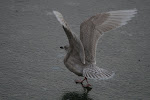Carl Partington, Bill Berry and Bill Gregory were already watching the bird and pointed it out to me. I was amazed to see the bird in my scope with a dark grey head! Being Lancashire birders, we were all unsure about the exact race of the bird (hence why Carl sent the news out as Yellow). I spend a long time in April 2008 in North East Spain watching flocks of Yellow Wagtail races in the same field. As a result, we began discussing the features of the bird and I personally felt that it was almost exactly the same as the birds I saw in Spain of the race 'cinereocapilla', or Ashy Headed Wagtail. The bird had a brilliant white throat, two tone grey head (with ear coverts being darker). At most angles of the bird, there was no obvious supercillium but occasionally the bird did show a faint white line above and behind the eye which is a variable characteristic of cinereocapilla. The images below are taken with Bill Gregory's Canon 7D and Canon 100-400mm lens through my 20x Kowa Scope (I know...a very unorthodox method!) in bright sunlight.


 I returned in the evening for the Whimbrel roost but arrived an hour earlier to get some more views of the wagtail to give a little more insight into the birds ID after a little more research on the subspecies. I viewed the bird with Chris Piner and Graham Piner, Chris Batty, Bill Gregory, Derek Gallagher and Reese, Mike Foley and other birders.
I returned in the evening for the Whimbrel roost but arrived an hour earlier to get some more views of the wagtail to give a little more insight into the birds ID after a little more research on the subspecies. I viewed the bird with Chris Piner and Graham Piner, Chris Batty, Bill Gregory, Derek Gallagher and Reese, Mike Foley and other birders.Speaking to Chris Batty, the BBRC are very reluctant to accept Ashy Headed Wagtail as the subspecies overlaps with iberiae in Southern France and produce regular hybrids. As a result, unless a bird shows no supercillium whatsoever, or a recorded call is submitted, there is a very good chance the bird will not be accepted as a pure cinereocapilla.
Chris Batty and I were really convinced by the bird so wanted to get as much information about this bird as possible. Chris filmed the bird for as long as his camcorder allowed to try and get a call on record. Sadly, the bird didn't call until near the end of Chris's film and missed the single call while he was momentarily paused the footage. We were however able to hear the call for ourselves and noted the call as being similar to standard 'flavissima' if not a little weaker. The bird took flight (when the bird called) and flew onto the quarry itself. Hopefully the call that we heard was only a half hearted and the video footage by Chris Batty will prove this birds true identity. Either way, this is a very beautiful bird and a very educational bird. If accepted, this will be the first for Lancashire and a wonderful site tick.
Also onsite during the visit: 97 Whimbrel into roost, 5+ Common Sandpiper, 4 LRP, 6 White Wagtail.

No comments:
Post a Comment